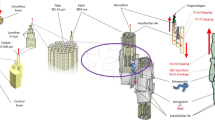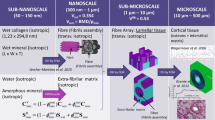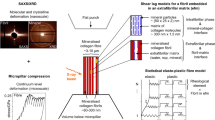Abstract
In this study, the homogenized anisotropic elastic properties of single bone lamellae are computed using a finite element unit cell method. The resulting stiffness tensor is utilized to calculate indentation moduli for multiple indentation directions in the lamella plane which are then related to nanoindentation experiments. The model accounts for different fibril orientation patterns in the lamellae—the twisted and orthogonal plywood pattern, a 5-sublayer pattern and an X-ray diffraction-based pattern. Three-dimensional sectional views of each pattern facilitate the comparison to transmission electron (TEM) images of real lamella cuts. The model results indicate, that the 5-sublayer- and the X-ray diffraction-based patterns cause the lamellae to have a stiffness maximum between 0° and 45° to the osteon axis. Their in-plane stiffness characteristics are qualitatively matching the experimental findings that report a higher stiffness in the osteon axis than in the circumferential direction. In contrast, lamellae owning the orthogonal or twisted plywood fibril orientation patterns have no preferred stiffness alignment. This work shows that the variety of fibril orientation patterns leads to qualitative and quantitative differences in the lamella elastic mechanical behavior. The study is a step toward a deeper understanding of the structure—mechanical function relationship of bone lamellae.
Similar content being viewed by others
References
Akiva U, Wagner H, Weiner S (1998) Modelling the three-dimensional elastic constants of parallel-fibred and lamellar bone. J Mater Sci 33(6): 1497–1509
Akkus O (2005) Elastic deformation of mineralized collagen fibrils: an equivalent inclusion based composite model. J Biomech Eng 127(3): 383–390
Ascenzi A, Bonucci E (1967) The tensile properties of single osteons. Anat Rec 158(4): 375–386
Ascenzi A, Bonucci E (1968) The compressive properties of single osteons. Anat Rec 161(3): 377–391
Ascenzi MG, Lomovtsev A (2006) Collagen orientation patterns in human secondary osteons, quantified in the radial direction by confocal microscopy. J Struct Biol 153(1): 14–30
Cusack S, Miller A (1979) Determination of the elastic constants of collagen by brillouin light scattering. J Mol Biol 135(1): 39–51
Fan Z, Swadener JG, Rho JY, Roy ME, Pharr GM (2002) Anisotropic properties of human tibial cortical bone as measured by nanoindentation. J Orthop Res 20(4): 806–810
Franzoso G, Zysset PK (2009) Elastic anisotropy of human cortical bone secondary osteons measured by nanoindentation. J Biomech Eng 131(2): 021001
Fratzl P, Weinkamer R (2007) Nature’s hierarchical materials. Prog Mater Sci 52(8): 1263–1334
Fritsch A, Hellmich C (2007) ‘Universal’ microstructural patterns in cortical and trabecular, extracellular and extravascular bone materials: micromechanics-based prediction of anisotropic elasticity. J Theor Biol 244(4): 597–620
Gebhardt W (1906) Ueber funktionell wichtige anordnungsweisen der feineren und groeberen bauelemente des wirbeltierknochens. ii. spezieller teil. der bau der haversschen lamellensysteme und seine funktionelle bedeutung. Arch Entwickl Mech Org 20: 187–322
Giraud-Guille M (1988) Twisted plywood architecture of collagen fibrils in human compact bone osteons. Calcif Tissue Int 42(3): 167–180
Giraud-Guille M, Besseau L, Martin R (2003) Liquid crystalline assemblies of collagen in bone and in vitro systems. J Biomech 36(10): 1571–1579
Gupta H, Zioupos P (2008) Fracture of bone tissue: the ‘hows’ and the ‘whys’. Med Eng Phys 30(10):1209–1226, special issue to commemorate the 30th anniversary of Medical Engineering & Physics—30th Anniversary Issue
Hengsberger S, Kulik A, Zysset P (2002) Nanoindentation discriminates the elastic properties of individual human bone lamellae under dry and physiological conditions. Bone 30(1): 178–184
Hofmann T, Heyroth F, Meinhard H, Fränzel W, Raum K (2006) Assessment of composition and anisotropic elastic properties of secondary osteon lamellae. J Biomechan 39(12): 2282–2294
Jasiuk I, Ostoja-Starzewski M (2004) Modeling of bone at a single lamella level. Biomech Model Mechanobiol 3(2): 67–74
Lees S, Prostak KS, Ingle VK, Kjoller K (1994) The loci of mineral in turkey leg tendon as seen by atomic force microscope and electron microscopy. Calcif Tissue Int 55(3): 180–189
Marotti G (1993) A new theory of bone lamellation. Calcif Tissue Int 53(Suppl 1):S47–55. (discussion S56)
McKee M, Nanci A (1996) Osteopontin at mineralized tissue interfaces in bone, teeth, and osseointegrated implants: Ultrastructural distribution and implications for mineralized tissue formation, turnover, and repair. Microsc Res Tech 33(2): 141–164
Pahr DH, Rammerstorfer FG (2006) Buckling of honeycomb sandwiches: periodic finite element considerations. Comput Model Eng Sci 12: 229–242
Pidaparti R, Chandran A, Takano Y, Turner C (1996) Bone mineral lies mainly outside collagen fibrils: predictions of a composite model for osternal bone. J Biomechan 29(7): 909–916
Raum K, Leguerney I, Chandelier F, Talmant M, Saied A, Peyrin F, Laugier P (2006) Site-matched assessment of structural and tissue properties of cortical bone using scanning acoustic microscopy and synchrotron radiation uct. Phys Med Biol 51: 733–746
Reisinger AG, Pahr DH, Zysset PK (2010) Sensitivity analysis and parametric study of elastic properties of an unidirectional mineralized bone fibril-array using mean field methods. Biomechan Model Mechanobiol. doi:10.1007/s10,237-010-0190-1
Rho J, Kuhn-Spearing L, Zioupos P (1998) Mechanical properties and the hierarchical structure of bone. Med Eng Phys 20(2): 92–102
Roy ME, Rho JY, Tsui TY, Evans ND, Pharr GM (1999) Mechanical and morphological variation of the human lumbar vertebral cortical and trabecular bone. J Biomed Mater Res 44(2): 191–197
Suquet P (1987) Lecture notes in physics—homogenization techniques for composite media. Chapter IV. Springer, Berlin
Swadener J, Pharr G (2001) Indentation of elastically anisotropic half-spaces by cones and parabolae of revolution. Philos Mag Lett 81(20): 447–466
Turner CH, Chandran A, Pidaparti RMV (1995) The anisotropy of osteonal bone and its ultrastructural implications. Bone 17(1): 85–89
Wagermaier W, Gupta HS, Gourrier A, Burghammer M, Roschger P, Fratzl P (2006) Spiral twisting of fiber orientation inside bone lamellae. Biointerphases 1(1): 1–5
Weiner S, Traub W (1992) Bone structure: from angstroms to microns. FASEB J 6(3): 879–885
Weiner S, Wagner H (1998) The material bone: structure-mechanical function relations. Annu Rev Mater Sci 28(1): 271–298
Weiner S, Arad T, Traub W (1991) Crystal organization in rat bone lamellae. FEBS Lett 285(1): 49–54
Weiner S, Arad T, Sabanay I, Traub W (1997) Rotated plywood structure of primary lamellar bone in the rat: orientations of the collagen fibril arrays. Bone 20(6): 509–514
Weiner S, Traub W, Wagner H (1999) Lamellar bone: structure-function relations. J Struct Biol 126(3): 241–255
Yao H, Ouyang L, Ching W (2007) Ab initio calculation of elastic constants of ceramic crystals. J Am Ceram Soc 90(10): 3194–3204
Yoon Y, Cowin S (2008) The estimated elastic constants for a single bone osteonal lamella. Biomech Model Mechanobiol 7(1): 1–11
Ziv V, Wagner HD, Weiner S (1996) Microstructure-microhardness relations in parallel-fibered and lamellar bone. Bone 18(5): 417–428
Zysset P, Guo X, Hoffler C, Moore K, Goldstein S (1999) Elastic modulus and hardness of cortical and trabecular bone lamellae measured by nanoindentation in the human femur. J Biomech 32(10): 1005–1012
Author information
Authors and Affiliations
Corresponding author
Rights and permissions
About this article
Cite this article
Reisinger, A.G., Pahr, D.H. & Zysset, P.K. Elastic anisotropy of bone lamellae as a function of fibril orientation pattern. Biomech Model Mechanobiol 10, 67–77 (2011). https://doi.org/10.1007/s10237-010-0218-6
Received:
Accepted:
Published:
Issue Date:
DOI: https://doi.org/10.1007/s10237-010-0218-6




